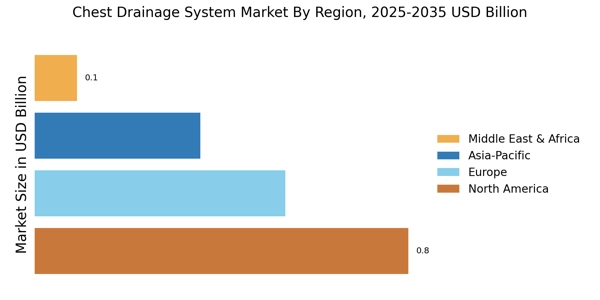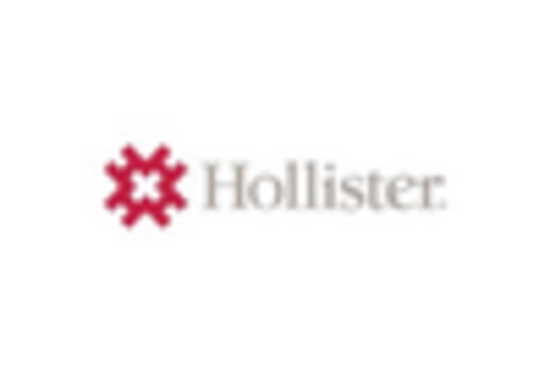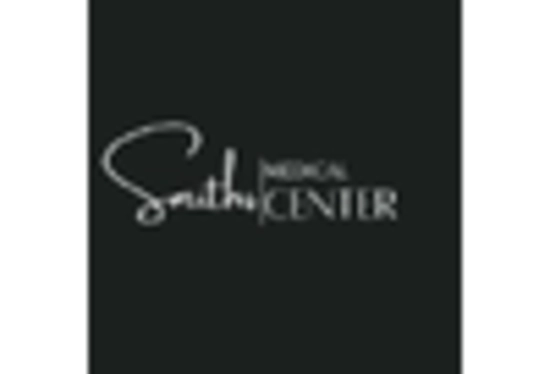Increasing Healthcare Expenditure
The Chest Drainage System Market is benefitting from the rising healthcare expenditure observed in various regions. Governments and private sectors are investing more in healthcare infrastructure, which includes the procurement of advanced medical devices. This trend is particularly evident in emerging economies, where healthcare systems are evolving to meet the demands of a growing population. Increased funding allows for the acquisition of state-of-the-art chest drainage systems, which are essential for effective treatment of thoracic conditions. Moreover, as healthcare providers strive to improve patient care, the emphasis on quality medical equipment becomes paramount. This surge in healthcare spending is likely to bolster the Chest Drainage System Market, as hospitals and clinics seek to enhance their service offerings and improve patient outcomes.
Expansion of Healthcare Facilities
The expansion of healthcare facilities is a significant driver for the Chest Drainage System Market. As new hospitals and clinics are established, particularly in underserved regions, the need for comprehensive medical solutions, including chest drainage systems, becomes increasingly apparent. This expansion is often accompanied by the integration of modern medical technologies, which enhances the overall quality of care provided. Additionally, existing healthcare facilities are upgrading their equipment to meet contemporary standards, further fueling the demand for advanced chest drainage systems. The establishment of specialized thoracic care units within hospitals also contributes to this trend, as these units require efficient and effective drainage solutions. Consequently, the growth of healthcare infrastructure is likely to have a positive impact on the Chest Drainage System Market, creating opportunities for manufacturers and suppliers.
Growing Awareness of Patient Safety
The Chest Drainage System Market is influenced by the increasing awareness surrounding patient safety and quality of care. Healthcare providers are prioritizing the implementation of systems that minimize risks associated with chest drainage procedures. This focus on safety is driving the demand for advanced chest drainage systems that incorporate features such as anti-reflux valves and infection control mechanisms. As patients and healthcare professionals alike become more informed about the potential complications of traditional drainage methods, the preference for safer, more reliable options is likely to grow. This shift in mindset is expected to propel the Chest Drainage System Market forward, as manufacturers respond to the demand for innovative solutions that enhance patient safety and satisfaction.
Rising Incidence of Respiratory Disorders
The Chest Drainage System Market is experiencing growth due to the increasing prevalence of respiratory disorders such as pneumonia, chronic obstructive pulmonary disease (COPD), and lung cancer. These conditions often necessitate the use of chest drainage systems to manage pleural effusions and pneumothorax. According to recent data, respiratory diseases account for a significant portion of global morbidity and mortality, leading to a heightened demand for effective treatment solutions. As healthcare providers seek to improve patient outcomes, the adoption of advanced chest drainage systems is likely to rise, thereby driving market expansion. Furthermore, the aging population, which is more susceptible to respiratory ailments, contributes to the growing need for these medical devices. This trend suggests a robust future for the Chest Drainage System Market as healthcare systems adapt to meet the needs of an increasingly affected demographic.
Technological Innovations in Medical Devices
Technological advancements play a pivotal role in shaping the Chest Drainage System Market. Innovations such as digital monitoring systems, automated drainage devices, and improved catheter designs enhance the efficacy and safety of chest drainage procedures. These advancements not only facilitate better patient management but also reduce the risk of complications associated with traditional methods. The integration of smart technologies allows for real-time monitoring of fluid levels and patient vitals, which can lead to timely interventions. As healthcare facilities increasingly adopt these cutting-edge solutions, the market is poised for significant growth. The introduction of minimally invasive techniques, supported by these technological innovations, further underscores the potential for expansion within the Chest Drainage System Market, as providers aim to enhance patient comfort and recovery times.


















Leave a Comment